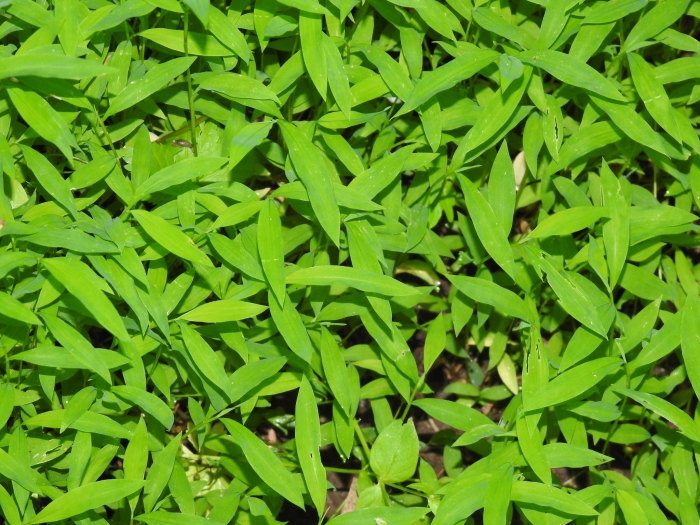Nepalese Browntop
(Microstegium vimineum)
Nepalese Browntop (Microstegium vimineum)
/
/

Surly Aardvark
Public Domain
Image By:
Surly Aardvark
Recorded By:
Copyright:
Public Domain
Copyright Notice:
Photo by: Surly Aardvark | License Type: Public Domain | License URL: http://creativecommons.org/publicdomain/zero/1.0/ | Rights Holder: Surly Aardvark | Publisher: iNaturalist | Date Created: 2021-06-05T10:25:06-07:00 |























































Estimated Native Range
Summary
Microstegium vimineum, commonly known as Nepalese Browntop, is an annual grass that originates from the understory of moist forests and along the banks of streams in East and Southeast Asia. It typically grows to heights between 40 and 100 cm (1.3 and 3.3 ft) and has a notable feature of rooting at each node, which allows it to spread rapidly. The plant produces delicate, greenish flowers in late summer, followed by seed production in the form of a caryopsis. Its ability to thrive in shaded conditions and its rapid growth rate make it a concern for outcompeting native vegetation.
Nepalese Browntop is often found in disturbed areas, making it a common invader of forest edges, roadsides, and riparian zones. It is not typically cultivated due to its invasive nature, but when it is, it requires part shade to full shade, medium amounts of water, and well-drained soils. In regions where it is not invasive, it may be used for erosion control due to its fast growth and ability to root at nodes. However, caution is advised as it can become problematic, forming dense mats that displace native flora and alter ecosystem processes.CC BY-SA 4.0
Nepalese Browntop is often found in disturbed areas, making it a common invader of forest edges, roadsides, and riparian zones. It is not typically cultivated due to its invasive nature, but when it is, it requires part shade to full shade, medium amounts of water, and well-drained soils. In regions where it is not invasive, it may be used for erosion control due to its fast growth and ability to root at nodes. However, caution is advised as it can become problematic, forming dense mats that displace native flora and alter ecosystem processes.CC BY-SA 4.0
Plant Description
- Plant Type: Grass
- Height: 2-3 feet
- Width: 0.2-0.4 feet
- Growth Rate: Rapid
- Flower Color: N/A
- Flowering Season: Summer, Fall
- Leaf Retention:
Growth Requirements
- Sun: Part Shade, Full Shade
- Water: Medium
- Drainage: Medium, Fast
Common Uses
Butterfly Garden, Deer Resistant, Drought Tolerant
Natural Habitat
Moist forests and stream banks in East and Southeast Asia
Other Names
Common Names: Nepal Grass, Chinese Packing Grass, Packing Grass, Japanese Stilt Grass, Flexible Sea Grass, Japanisches Stelzengras, 柔枝莠竹, Asian Stilt Grass, Japanese Grass, Mary’s Grass
Scientific Names: , Microstegium vimineum, Microstegium vimineum var. vimineum, Microstegium vimineum f. willdenowianum, Microstegium vimineum var. polystachyum, Microstegium vimineum var. imberbe, Microstegium vimineum f. polystachyum, Microstegium nodosum, Eulalia viminea, Microstegium imberbe
GBIF Accepted Name: Microstegium vimineum (Trin.) A.Camus